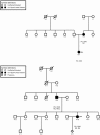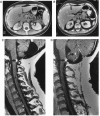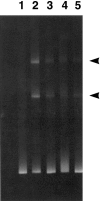Mosaicism in von Hippel-Lindau disease: lessons from kindreds with germline mutations identified in offspring with mosaic parents
- PMID: 10631138
- PMCID: PMC1288351
- DOI: 10.1086/302726
Mosaicism in von Hippel-Lindau disease: lessons from kindreds with germline mutations identified in offspring with mosaic parents
Abstract
von Hippel-Lindau disease (VHL [MIM 193300]) is a heritable autosomal dominant multiple-neoplastic disorder with high penetrance. It is characterized by brain and spinal-cord hemangioblastomas, retinal angiomas, clear-cell renal carcinoma, neuroendocrine tumors and cysts of the pancreas, pheochromocytomas, endolymphatic-sac tumors, and papillary cystadenomas of the epididymis and broad ligament. Although most index cases have a positive family history of VHL, some do not and may represent de novo cases. Cases without a family history of VHL may or may not have a germline mutation in their VHL tumor-suppressor gene. We present two cases of VHL mosaicism. In each of two families, standard testing methods (Southern blot analysis and direct sequencing) identified the germline mutation in the VHL gene of the offspring, but not in their clinically affected parent. Additional methods of analysis of the affected parents' blood detected the VHL-gene mutation in a portion of their peripheral blood lymphocytes. In one case, detection of the deleted allele was by FISH, and, in the second case, the 3-bp deletion was detected by conformational sensitive gel electrophoresis and DNA sequencing of cloned genomic DNA. Mosaicism in VHL is important to search for and recognize when an individual without a family history of VHL has VHL. Patients diagnosed without family histories of the disease have been reported in as many as 23% of kindreds with VHL. Identification of individuals potentially mosaic for VHL will affect counseling of families, and these individuals should themselves be included in clinical screening programs for occult disease.
Figures





References
Electronic-Database Information
-
- Online Mendelian Inheritance in Man (OMIM), http://www.ncbi.nlm.nih.gov/Omim/ (for VHL [MIM 193300]) - PubMed
References
-
- Austin KD, Hall JG (1992) Nontraditional inheritance. Pediatr Clin North Am 39:335–348 - PubMed
-
- Chen F, Kishida T, Yao M, Hustad T, Glavac D, Dean M, Gnarra JR, et al (1995) Germline mutations in the von Hippel-Lindau disease tumor suppressor gene: correlations with phenotype. Hum Mutat 5:66–75 - PubMed
-
- Choyke PL, Glenn GM, Wagner JP, Lubensky IA, Thakore K, Zbar B, Linehan WM, et al (1997) Epididymal cystadenomas in von Hippel-Lindau disease. Urology 49:926–931 - PubMed
-
- Choyke PL, Glenn GM, Walther MM, Patronas NJ, Linehan WM, Zbar B (1995) von Hippel-Lindau disease: genetic, clinical, and imaging features. Radiology 194:629–642 (erratum Radiology 196:582) - PubMed
Publication types
MeSH terms
LinkOut - more resources
Full Text Sources
Medical
Molecular Biology Databases

